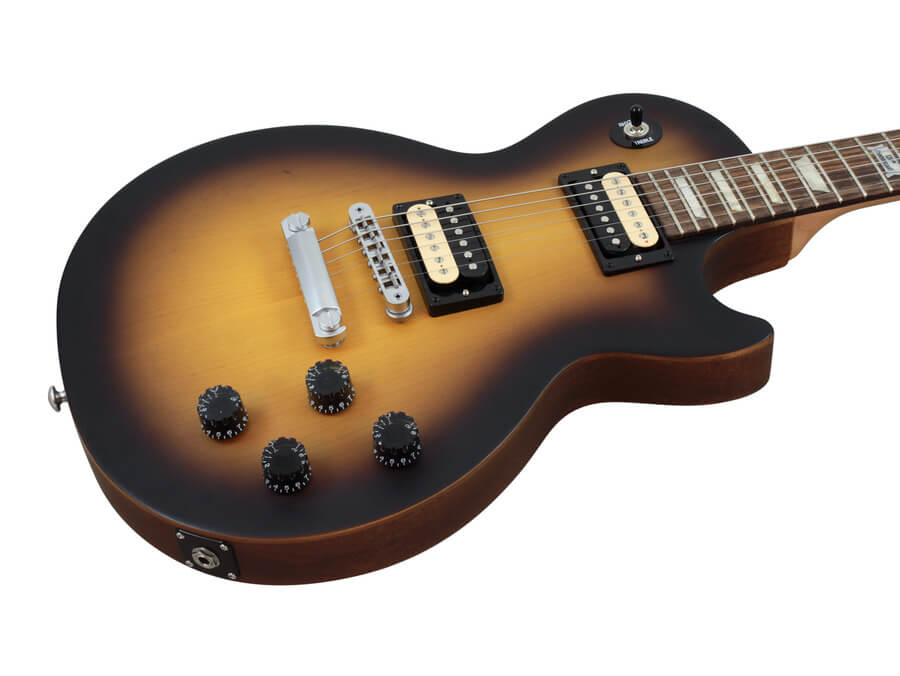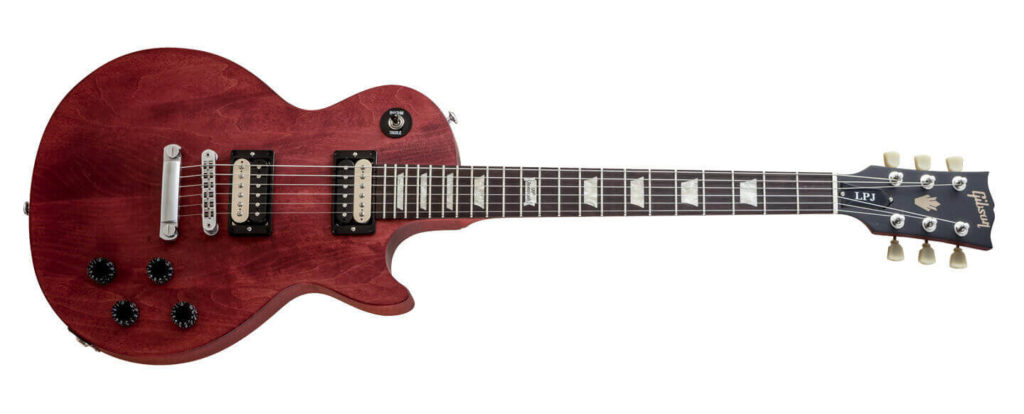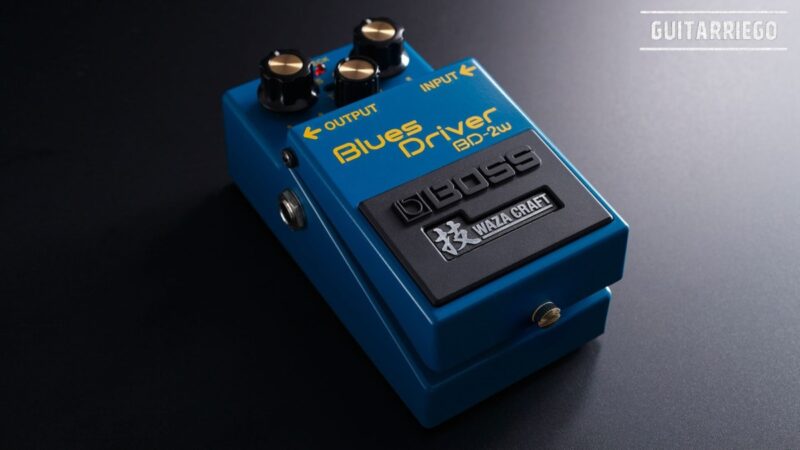Gibson LPJ 2014 review: Is it a Les Paul?

Gibson LPJ 2014, review of one of the cheapest Gibson models, which despite its great price does not sacrifice performance.
By Freddie Valle
Gibson LPJ 2014 Review
For this review, the following entry-level and mid-range instruments were used as a reference:
- SX Les Paul with Seymour Duncan Alnico II Pro set
- Epiphone Les Paul Standard with Seymour Duncan Alnico II Pro set
- Gibson Les Paul Studio 2010 -Chambered con Set 490R/498T-
Review de Gibson LPJ 2014 made in USA
Gibson LPJ 2014 quality and robustness

Beyond being an accessible line, the LPJ is still an American Gibson and has great quality. While you can tell a big difference from the Les Paul Studio or any other Gibson top line guitar, the difference you feel against an Epiphone Standard is also important.
Hardware
The Hardware is very similar, if not the same as that of the Studio, and marks a significant difference from the Epiphone Standard. These differences are very noticeable, especially with regard to the bridge and tailpiece.
Gibson LPJ 2014 Woods
They are probably made up of a larger number of smaller pieces, and surely made of the same wood as the Studio, and with a higher quality than the Epiphone.
The body is Mahogany with a solid Maple Top with “9 holes weight relief”. At this point it has the same as a pure and hard Les Paul but both finer.

In the case of the neck, the wood is Maple, like some Les Pauls from the 70’s, instead of the classic mahogany neck. The fretboard or fretboard is Rosewood.

The latter makes them have a more brilliant Les Paul sound and not so dull and medium. The Gibson LP Studio has a richer / more complex sound, more body, and more rounded highs. This, and the difference in pickups, does not allow a fair comparison between the guitars.
In the following video you can hear perfectly the tonal differences between the LPJ and the Les Paul Studio:
Gibson LPJ 2014, is it a Les Paul or not?
Fundamentalists will not see the LPJ as a true Les Paul. In my humble opinion it is a Les Paul, not the most classic and higher quality version, but it is just my opinion. Let’s remember that during the 70’s there were years that came with a maple neck. These are considered by some to be more “defined” and with more “attack”, ideal for heavy metal styles. An example is Zakk Wylde’s guitar.
The LPJ has good sustain, comes with a 50’s profiled neck. For classic rockers and bluesmen it’s very good, clearly not so good for those looking for more speed.
Finishing of the LPJ: the Achilles heel
The finish of the LPJ is a fine satin finish, and one of the low cost points for this guitar. According to the specifications on the Gibson website, it is a “Sealer: Nitrocellulose; Process: 1-1.5 mils. »
This finish only serves aesthetic purposes, but not protection. Even if one takes good care of the instrument, the mere use will cause it to lose its paint and begin to show the color of the wood, which inevitably causes it to have a natural relic finish in a few years.
If you compare it to the Studio, which has a “Hi Gloss Lacquer / 90 Sheen 7–8 mils” finish, which protects the instrument well, you notice a big difference in quality in the finish. The finishing process is one of the most expensive processes and where costs are most easily reduced.

But not all of them are cons, the hand on the satin of the LPJ runs much better, the feel on the neck is barbaric.
In short, the super light, satin finish does not protect the woods of the guitar. For those who care more about the sensation, the touch and are not so concerned about the aesthetic aspect, it is a point with which you can live.
On the other hand, if you like well-kept guitars and don’t mind the “stickiness” of the Hi Gloss, the finish of the LPJ is somewhat unacceptable.
Gibson ’61 Pickups
Gibson ’61s are pickups made with Alnico V, with unbalanced winding, to simulate old manual manufacturing. They have a moderate output and some brightness. They are not much appreciated by the market, but they are undoubtedly superior to the Epiphones.
Gibson LPJ 2014 vs LPJ 2013
Mostly the changes are aesthetic: colors, black hardware in 2013 and satin silver in 2014, EMG-type pickup covers in 2013 vs opencoil zebra in 2014.

Beyond those aesthetic changes, Gibson reports that the 2014 has a cryogenized treaty on the frets to make them last longer. Finally, the most relevant change is that of the pickups, the 2013 version brings the classic 490R and 490T pickups, normal on the SG Special. Those pickups are medium / vintage output with extra mids, a good choice to pair with a maple neck that is less midsize than a mahogany one.
Which is better? a matter of taste, no doubt.
On a general level, after having used it for 6 months, I can say that the LPJ can disappoint the fundamentalists of the pure and hard Les Pauls. They are brighter and less mean. They come with vintage specs: Rounded 50’s fat neck and PAF look-alikes.
Gibson LPJ review conclusion
They are very beautiful guitars, especially for those who want a not so fat sound, and with more attack and definition than a classic “Paula”, and as long as one is not very sensitive to the aesthetic issue. The touch feel is great, the satin gives it some weakness in the protection and care aspect, but to the touch it is much better than the Hi Gloss of the Les Paul Studio with which we made the comparison.
Comparing it to the Epiphone Les Paul Standard, the LPJ is way over the top, beyond the fact that the end of the Epi is much more beautiful. However, after doing this review I had the opportunity to have an Epiphone Les Paul Tribute 60’s. This guitar is a top-of-the-range model of the brand. They come with a solid maple top, with Gibson-like electronics and Gibson ’57 Classic pickups. It had an impeccable fit, I wish I had compared the two hand-to-hand. I dare say that Epiphone Tribute was on par with the LPJ. Here, you can see our opinion of the Epiphone Les Paul Standard Tribute 1960.

My conclusion from this 2014 LPJ review is that it is a good option to access a Gibson at an affordable value.
You can visit the product website on the Gibson page.






